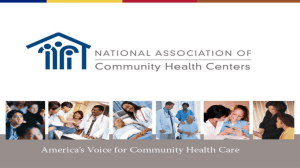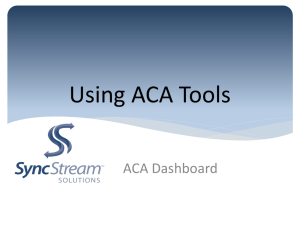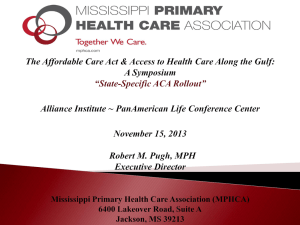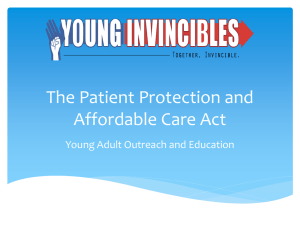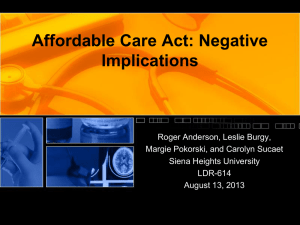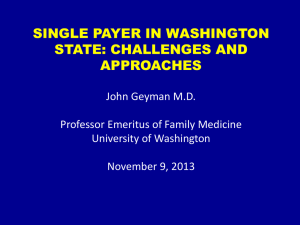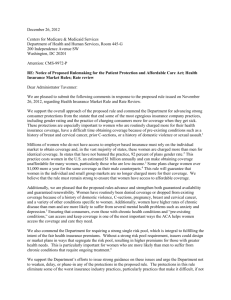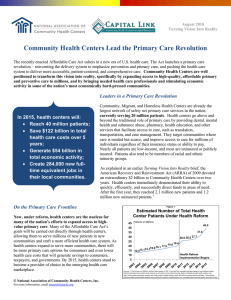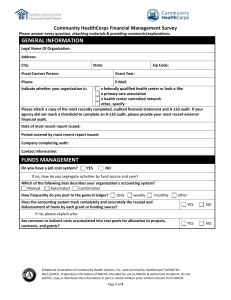Joe Gallegos, National Association of Community Health Centers
advertisement
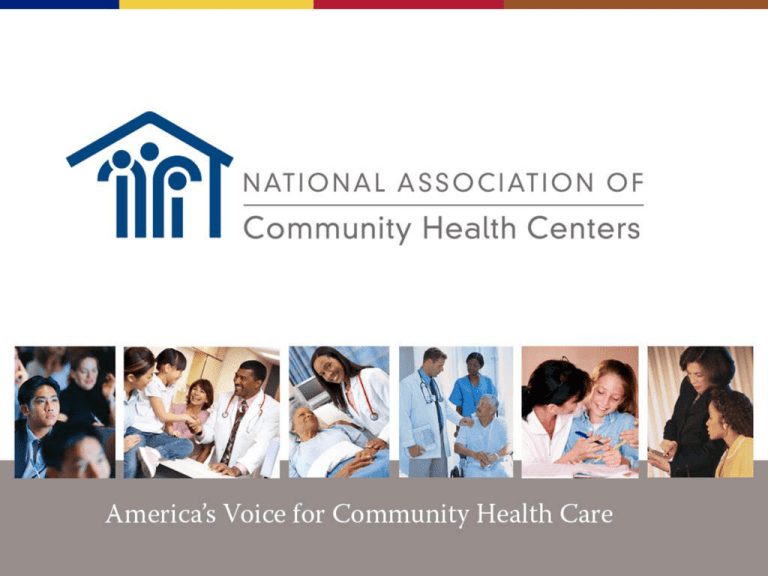
Federal Policy Update Great Basin Primary Care Association – Annual Meeting Joe Gallegos, MBA SVP for Western Operations National Association of Community Health Centers September 10, 2013 America’s Voice for Community Health Care The NACHC Mission To promote the provision of high quality, comprehensive and affordable health care that is coordinated, culturally and linguistically competent, and community directed for all medically underserved people. THE AFFORDABLE CARE ACT - A QUICK REFRESHER - Health Center Funding and the Affordable Care Act • The Affordable Care Act (ACA) provided $11 billion in Mandatory funding for health center operations and capital for FY 2011 thru FY 2015. –$9.5 billion to support health center operations. –$1.5 billion for capital needs. • Mandatory funding provided through the ACA Health Center Trust Fund ends after FY2015. ACA Planned Funding for Health Centers & Estimated New Patients* 45 Patients in Millions Funding in Billions 40 40.0 35 26.0 26.5 $2.5 27.7 25 20 $3.5 $3.0 31.6 30 $4.0 $2.0 19.4 18.8 $1.5 17.0 15 $1.0 Health Reform Implementation Begins 10 $0.5 5 $0.0 2008 2009 2010 2011 2012 2013 2014 2015 Sources: Data for federally-funded health centers only. FY00-08 are from HRSA’s Uniform Data System. FY09 -15 are NACHC projected estimates based on new federal funding. NACHC estimates future health center patients as a function of new federal funding. Note: Other factors are difficult to predict and include payer mix, growth in non-federal grant sources, and the costs of care, which may be related to new patients having unmet health needs. Patient growth will be contingent on continuation of federal, state, and local support over the period. * Prior to FY2011 $600 million reduction, Health Center Funding Under Current Law Community Health Center Funding: FY 2010 – FY 2016 Other Key Provisions for Health Centers • Medicaid Expansion to 133% FPL: The elimination of categories of eligibility will greatly expand insurance for health center patients • Menendez Amendment: Guaranteed Medicaid PPS Payment Level for FQHCs from Qualified Health Plans under Exchanges/Marketplaces • Medicare: Modified Medicare PPS for FQHCs, Inclusion of all preventive benefits and Elimination of current provider productivity caps and screens Some Key Features of the ACA • Prohibits insurance companies from denying coverage because of an individual’s pre-existing condition. • Prohibits new health plans and existing group plans from imposing dollar limits on the amount of coverage an individual may receive. • Extends coverage for Young Adults under parents’ plan until they turn 26 years of age. • Paying Physicians Based on “Value” not “Volume”. • Small Business Health Options Program (SHOP) simplifies and makes health insurance coverage for employees of small business more affordable. Some Key Features of the ACA 2010: Patient Bill of Rights and Cost-free Preventive Services 2011: People on Medicare receive key preventive services for free and 50% discount on brand-name drugs “donut hole” 2012: ACOs and other programs help health care providers work together to deliver better care—higher quality and lower cost 2013: Open enrollment in Health Insurance Marketplace begins October 1, 2013 2014: Effective January 1, 2014, 30 million low to moderate income Americans will gain coverage through Medicaid expansion or through premium subsidies. Millions will gain coverage for the very first time. NOTE: Who is left out of Coverage? Undocumented Immigrants. Undocumented Immigrants who arrived in U.S. as Children – Deferred Action for Childhood Arrivals (DACA) (estimated 900,000) Status of State Medicaid Expansion for 2014 FY 2013 APPROPRIATIONS President’s 2013 Budget Proposal • Budget included $3.1 billion for Health Centers, a $300 million increase over FY 2012: $1.6 billion discretionary, $1.5 billion mandatory (ACA) • BUT, proposed to “hold back” $280 million of the $300 million increase as a way to avert the funding cliff Result would be: only 25 New Access Points (NAPs), no other expansion or base adjustments Result: Needed Congress to legislatively compel the Administration to spend the full increase ($300 million) in FY 2013. FY 2013 Appropriation/Spending Plan FY 2013 Spending Plan ($300 Million) • $115 +/- million sequester - “backfill” • $48 million – Base Grant Adjustments (to be announced mid-September) • $19 million – New Access Points (20-25 NAPs) (to be announced mid-September) • $118 million – Outreach & Enrollment Assistance for health centers and S/RPCAs* *Note: Total O&E grant was $156 million---not all from CHC funds A LOOK AHEAD: CONGRESS AND APPROPRIATIONS Legal Analysis 16 Major Flash Points – Debt limit: Expect to reach the $16.7 Trillion limit by MidOctober. Some Congressional leaders are demanding a budget agreement – potential threat to entitlement programs – Sequester resumption: $110 Billion in automatic cuts, ½ from non-defense effective October 1, 2013 unless alternate cuts are approved (For CHCs = $115 million/900,000 patients not served) – Grand or Petite bargain on Federal Budget: bipartisan groups continue to search for compromise – Defund Obama Care or shut down Federal government operations – Immigration Reform: S. 744 passed the Senate, now debate moves to the House NACHC PRIORITIES FOR FY 2014 NACHC’s 2014 Overarching Priorities –Avoid further cuts in Section 330 funding • Secure full use of ACA funds to offset any sequester/ deficit reductions & to support growth where possible in FY 2014 • Get key members of Congress to commit to address 2015 CHC funding cliff (when ACA funding expires) –Limit impact to Medicaid (& Medicare & ACA) to avoid cuts in eligibility, benefits, & payment (esp. PPS) –Preserve CHCs as open to ALL individuals (including immigrants) The Health Center FY2014 Request Total Funding of $3.8 billion, breaks down to: • $1.6 billion in discretionary funding • $2.2 billion in mandatory ACA funding = increase of $700 million over FY 2013 What $700 million Can Do… • $95 million in Base Grant Adjustments • $350 million for New Access Points – potential to serve an additional 3 million new patients • $255 million for Expanded Medical Capacity (EMC) and Service Expansion (medical, dental, behavioral health, pharmacy and vision services and enabling services) Congressional Support Letters • House: Pallone/ Bilirakis Letter: –194 Bipartisan Cosigners • Senate: Wicker/ Stabenow Letter: –54 Bipartisan Cosigners • BUT we know of an additional 7 Senators who sent in their individual support letters for the CHC program. • 61 Senators or the majority of the Senate supports funding for the CHC Program in FY14 Highest level of Congressional support in 3 years!!! July 2013: The Senate FY 2014 LHHS Bill – VICTORY! What is in the bill for CHCs: Full funding- $3.8 billion/ $700 million increase Legislative text requiring the Administration to spend the full $700 million increase by Sep.30th, 2014 on: • New Health Center Sites • Expanded Medical Capacity • Service Expansion $142 million in Outreach & Enrollment funds rolled into base grant adjustments- -making them permanent $95 million in the Federal Tort Claims Fund Where is the House??? Too Much Gridlock – Scheduled and then Cancelled House FY14 LHHS Bill Markup • The dueling Budgets and lack of sequester repeal are stalling the LHHS Bill. • House Allocation is 25.9% less or $142 billion lower than the Senate • Too soon to tell how the House will proceed– expect that many programs will face steep reductions • Most likely we will face another Continuing Resolution. FTCA Malpractice Coverage for Volunteers • Sen. John Thune (R-SD) and Sen. Bob Casey (D-PA) introduced S. 955, the Family Health Care Accessibility Act of 2013. • Extends Federal Tort Claims Act (FTCA) malpractice coverage to health practitioners volunteering at Section 330-funded health centers. • Rep. Tim Murphy and Rep. Gene Green introduced the Family Healthy Care Accessibility Act (H.R. 2703)— companion bill to S.955. Outreach and Enrollment Outreach and Enrollment Grants for CHCs • On May 9, 2013, HRSA distributed grants to Health Centers and S/RPCAs in the amount of $150 million to help uninsured individuals gain affordable health insurance coverage. • Last month, CMS awarded a total of $67 million to 105 Navigator grant applicants in Federally-facilitated and State Partnership Marketplaces to assist individuals who are eligible for marketplace coverage to select a plan that best meets their needs. • This year (2013) is the time to get ready and prepare for January 1, 2014 when 30 million Americans gain coverage, many who will gain coverage for the first time. Get ready by conducting “in-reach” and “community outreach” to assist individuals in getting enrolled. What should health centers be doing? • Recruit Outreach and Enrollment Assistance Workers • Train Outreach and Enrollment Assistance Workers • Plan for and conduct outreach and enrollment activities • Take advantage of PCA, HRSA and CMS resources, training and technical assistance (i.e., in-reach and outreach) • Report on progress: # of staff trained; # of individuals assisted; # of individuals determined to be eligible and # of individuals enrolled Important ACA websites http://www.healthcare.gov http://marketplace.cms.gov/ http://hrsa.gov/affordablecareact/ What is the Outlook? 202-457-6267 Outlook Have confidence that, whatever the battles ahead may be --- we can win. • Few can match our record --- and few programs can deliver what we offer: • Value in the quality care we deliver; • Value in expanding access and improving health; • Value in delivering cost savings PLUS some $20 billion dollars in jobs and economic activity for communities. Where Can I Get More Information? •Website: –NACHC.org > Policy Issues > Federal –Talking points, newest research and data, webcasts and trainings •Blog: –Health Centers on the Hill •Washington Update: –Sign up to be a Health Center Advocate Thank You! Any Questions?
